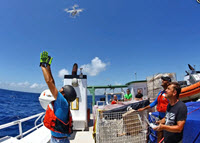
Many factors affect how the ocean moves, and it is especially difficult to know exactly how it will behave in a specific area, as was evident with challenges in predicting oil transport during Deepwater Horizon. The Smithsonian’s Ocean Portal published an article that describes tools scientists use to track currents on and just beneath the ocean’s surface, such as drifters, autonomous underwater vehicles, planes, and video equipment attached to ship-tethered balloons and drones.
Read the article Five Methods For Tracking The Ocean’s Motion featuring the Consortium for Advanced Research on Transport of Hydrocarbon in the Environment (CARTHE). Their research is helping us learn more about how currents and waves move water and floating material (such as spilled oil and plastics).
Read these related stories:
- Science at Sea: SPLASH Experiment Improves Predictions for Oil Moving toward Shore
- LASER Focus Advances Knowledge of How Gulf of Mexico Water Moves
- Scientists Use Oil Spill Research to Track Pollution in Biscayne Bay
- Study Describes Design and Testing of an Effective Biodegradable Ocean Drifter
By Nilde Maggie Dannreuther. Contact maggied@ngi.msstate.edu with questions or comments.
************
GoMRI and the Smithsonian have a partnership to enhance oil spill science content on the Ocean Portal website.
The GoMRI is a 10-year independent research program established to study the effect, and the potential associated impact, of hydrocarbon releases on the environment and public health, as well as to develop improved spill mitigation, oil detection, characterization and remediation technologies. An independent and academic 20-member Research Board makes the funding and research direction decisions to ensure the intellectual quality, effectiveness and academic independence of the GoMRI research. All research data, findings and publications will be made publicly available. The program was established through a $500 million financial commitment from BP. For more information, visit https://gulfresearchinitiative.org/.
© Copyright 2010-2019 Gulf of Mexico Research Initiative (GoMRI) – All Rights Reserved. Redistribution is encouraged with acknowledgement to the Gulf of Mexico Research Initiative (GoMRI). Please credit images and/or videos as done in each article. Questions? Contact web-content editor Nilde “Maggie” Dannreuther, Northern Gulf Institute, Mississippi State University (maggied@ngi.msstate.edu).
